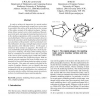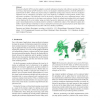20 search results - page 2 / 4 » Smooth force rendering on coarse polygonal meshes |
TVCG
2011
13 years 4 days ago
2011
—Haptic texture represents the fine-grained attributes of an object’s surface and is related to physical characteristics such as roughness and stiffness. We introduce an inter...
CGI
1997
IEEE
13 years 8 months ago
1997
IEEE
In order to achieve the impression of a smooth surface while rendering a polygon mesh, normal vector vectors may be provided in the vertices of the mesh that are the average of th...
VMV
2003
13 years 6 months ago
2003
Ellipsoids are important primitives used in visualization and modeling, where often a larger number of ellipsoids have to be displayed in real-time. The standard approach of tesse...
CGF
2008
13 years 5 months ago
2008
We present a flexible GPU kernel for adaptive on-the-fly refinement of meshes with arbitrary topology. By simply reserving a small amount of GPU memory to store a set of adaptive ...
HAPTICS
2002
IEEE
13 years 10 months ago
2002
IEEE
Soft objects are often desired in applications such as virtual surgery training. Soft object simulations are computationally intensive because object deformation involves numerica...


